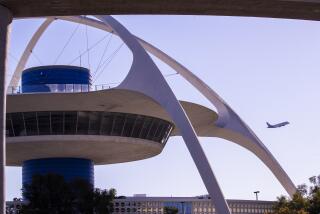Air Force Limits Flights After Airliner Incidents
- Share via
WASHINGTON — The Air Force sharply expanded its restrictions on military flights over much of the nation Monday, after a succession of incidents in which combat jets approached close enough to civilian passenger jets to trigger cockpit warning alarms.
After disclosing two new incidents involving military and commercial aircraft, the Air Force suspended training in special zones in the Gulf of Mexico. Last week training flights were suspended in areas along the East Coast.
The latest incidents, disclosed Monday, occurred Friday when two F-16 jet fighters crossed into the safety zone surrounding a passenger jet operated by American Airlines and a single F-16 entered the zone of a Northwest Airlines airliner.
The Air Force official insisted Monday that none of the incidents involved near misses, which he defined as 500 feet of separation.
The standard safety margin maintained by Federal Aviation Administration controllers calls for a horizontal separation of two miles and a vertical separation of 1,000 feet over land, though cockpit warning alarms are designed to sound long before aircraft get that close.
All the incidents have come to light because of the Traffic Collision Avoidance System, new cockpit equipment that sets off an alarm to notify a pilot when his aircraft is in potential danger of in-flight collision. When the alarms sounded in the recent incidents, they were reported to the Federal Aviation Administration, which notified the Air Force.
Safety experts said Monday that separation problems between military and civilian air traffic have existed for decades but only now are coming to light because of the new cockpit equipment.
An Air Force spokesman acknowledged that the service does not understand what has triggered the rash of incidents but said that military officials are taking them seriously and want to exercise as much caution as possible.
The West Coast, which includes large military air spaces both in the Pacific and over the California desert, was not included in the order because military and civilian air traffic do not operate as close to each other as they do in the East, an Air Force official said.
“There has always been a problem,” said C.O. Miller, a former government accident investigator who is now a safety consultant. “These things go on all the time. Private pilots have been bitching about this for years.”
*
The National Transportation Safety Board is investigating the incidents, the first such inquiry in more than a decade. The safety board plans to review air traffic control voice tapes, radar tapes and flight data recorders as part of its investigation. The FAA is also reviewing its procedures.
The new cockpit equipment sounds an alarm when an aircraft flies within a protective safety zone of another aircraft. The size and shape of that safety zone vary, depending on the direction and speed of the two aircraft. But the zone is often much larger than the FAA standard margin of 2 miles and 1,000 vertical feet.
Under the stand down announced Monday, the Air Force suspended training in dozens of training areas, in which pilots practice dog-fighting and other combat maneuvers.
Air Force officials said they will require their pilots to review regulations applying to joint air space before conducting training operations. The reviews take from several hours to a day and many pilots should be cleared for a resumption of training by today, the Air Force said.
When the training zones are “hot,” meaning that they are being used for war games, civilian traffic is routed around or above them. But in several of the incidents, combat pilots strayed outside the military training spaces.
*
The most serious incident involved two F-16s that closed in Wednesday on a Boeing 727 passenger jet bound for Kennedy International Airport. The jetliner’s pilot took sudden evasive action, throwing three passengers and crew members to the floor. The fighters came within 1,000 feet of the jetliner, Defense Department officials said.
The second incident occurred when an Air National Guard F-16 passed an American Eagle commuter plane off the Maryland coast at closer than 1,000 feet vertical separation, the officials said.
In the incidents disclosed Monday, an F-16 from Kelly Air Force Base in Texas, flying near Clovis, N.M., came within 4.6 miles, with 300 vertical feet of separation, of a Northwest Airlines jetliner flying from Mexico to Detroit.
The second incident Friday involved two F-16s that were flying above the ceiling for military operations. While they were descending into their proper air space, one of the jets triggered an avoidance alarm on an American Airlines jet over Palacios, Texas, en route from Dallas-Fort Worth to Palm Springs. The aircraft were about 3.5 miles apart and flying within about 300 feet vertically, the spokeswoman said.
More to Read
Sign up for Essential California
The most important California stories and recommendations in your inbox every morning.
You may occasionally receive promotional content from the Los Angeles Times.














